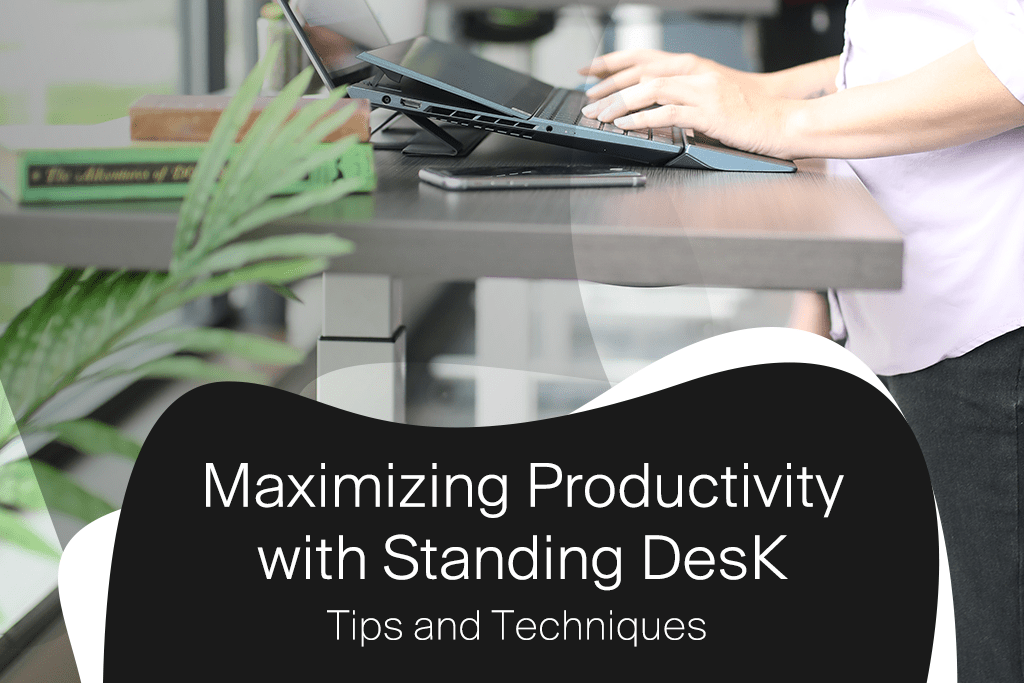In today’s fast-paced and competitive work environment, productivity is a key factor that can significantly impact the success of individuals and businesses alike. Being productive means effectively utilizing your time and resources to achieve your goals and deliver high-quality work. It is the driving force behind accomplishing tasks efficiently, meeting deadlines, and ultimately, achieving success.
Productivity is not just about working harder or longer hours; it’s about working smarter. It’s about finding ways to optimize your workflow, eliminate distractions, and maintain focus on the tasks that matter most. When productivity is high, individuals can accomplish more in less time, leading to increased job satisfaction, reduced stress levels, and even improved work-life balance.
One effective tool that has gained popularity in recent years for enhancing productivity is the standing desk. The traditional sedentary work style of sitting for prolonged periods has been linked to various health issues, such as back pain, obesity, and decreased energy levels. Recognizing these challenges, the concept of using a standing desk as a productivity-enhancing tool has emerged.
A standing desk, as the name suggests, allows you to work while standing rather than sitting. It provides an adjustable surface that allows you to switch between sitting and standing positions as desired. This concept aims to break free from the sedentary lifestyle and encourage a more active and dynamic approach to work.
The idea behind using a standing desk is that it helps combat the negative effects of prolonged sitting. Standing, improve blood circulation, and muscles and promote better posture. These physical benefits not only contribute to your overall well-being but also have a direct impact on your productivity and performance in the workplace.
Benefits of using a standing desk
Using a standing desk offers a range of benefits that can positively impact both your physical and mental well-being. Let’s explore some of the key advantages that come with incorporating a standing desk into your work routine:
1. Improved Posture and Reduced Back Pain
One of the most significant benefits of using a standing desk is the improvement in posture it can provide. Sitting for long periods can lead to poor posture, which can contribute to back, neck, and shoulder pain. By standing while working, you naturally engage your core muscles, maintain a more upright position, and alleviate the strain on your spine. This can help reduce discomfort and promote a healthier posture over time.
2. Increased Energy and Focus
When you stand, your blood circulation improves, delivering more oxygen and nutrients to your brain. This increased blood flow can lead to heightened alertness, improved concentration, and a boost in energy levels. By staying more engaged and focused, you can tackle tasks with greater efficiency and productivity.
3. Enhanced Blood Circulation and Overall Health
Prolonged sitting can hinder blood circulation, leading to a range of health issues. Using a standing desk promotes better blood flow throughout your body, reducing the risk of cardiovascular problems and other related conditions. Improved circulation means that vital organs receive a steady supply of oxygen and nutrients, keeping your body functioning optimally. Additionally, standing encourages subtle movements and muscle contractions that can help prevent stiffness and muscle imbalances.
4. Potential Calorie Burn and Weight Management
While it may not replace a dedicated workout routine, using a standing desk can contribute to calorie burn and weight management. When compared to sitting, standing burns slightly more calories due to increased muscle activity and engagement. Over time, this can make a difference in maintaining a healthy weight. Additionally, the act of standing can make you more conscious of your body posture and encourage small movements that can further aid in calorie expenditure.
Transitioning to a Standing Desk
Transitioning to a standing desk requires an adjustment period as your body adapts to a new way of working. To ensure a smooth transition and reap the benefits of a standing desk effectively, consider the following tips:
1. Start Gradually and Listen to Your BodyWhen you first start using a standing desk, it’s important to ease into it gradually. Begin by standing for short intervals, such as 15-30 minutes at a time, and gradually increase the duration as your body adjusts. Pay attention to any discomfort or fatigue and take breaks when needed. Everyone’s body is different, so find a standing duration that works best for you.
2. Incorporate Sitting Breaks and Movement
While standing offers numerous benefits, it’s essential to incorporate sitting breaks and movement throughout your workday. Prolonged standing can lead to fatigue and strain, just as prolonged sitting can. Take short sitting breaks every 30-60 minutes to rest your legs and provide relief to your body. During these breaks, you can perform stretches or take a short walk to promote blood circulation and prevent stiffness.
3. Finding the Right Balance Between Standing and Sitting
The key to optimizing the benefits of a standing desk is finding the right balance between standing and sitting. Every individual’s needs and preferences may differ, so it’s important to experiment and find a balance that works for you. Some people find that alternating between sitting and standing in specific time intervals, such as 30 minutes of sitting followed by 30 minutes of standing, works well. Others may prefer a more flexible approach, adjusting their position based on their energy levels and the tasks at hand.
Remember, the goal is not to solely replace sitting with standing but to incorporate movement and variation into your work routine. The ability to switch between sitting and standing allows you to find the optimal balance that keeps you comfortable, productive, and engaged throughout the day.
Standing Desk Accessories and Tools
To enhance your standing desk experience and create an ergonomic and efficient workspace, consider incorporating the following accessories and tools:
Mats for Added Comfort
Standing on a hard surface for extended periods can lead to discomfort and fatigue. Investing in an anti-fatigue mat like foot rest can provide cushioning and support for your feet, legs, and joints. These mats are designed to reduce the strain on your body by offering a more comfortable standing surface. Look for a mat with adequate thickness and a non-slip surface to ensure stability.
Monitor Stands and Document Holders
Proper positioning of your monitor(s) is essential to maintain good posture and prevent neck and eye strain. Monitor stands to elevate your screen to eye level, reducing the need to tilt your head up or down. Look for a stand or monitor that provides height adjustment and tilt options for optimal viewing angles.
Additionally, a document holder can be beneficial if you frequently refer to physical documents or papers while working. It keeps your documents at eye level, minimizing the need to strain your neck or hunch over your desk.
Cable Management
A cluttered workspace can be distracting and hinder your productivity. Use cable management solutions to keep your cables organized and out of the way. Cable clips, cable trays, or cable sleeves can help route and secure your cables, preventing them from tangling or becoming a trip hazard. A tidy workspace promotes a more focused and efficient environment.
Other accessories that you might consider include a standing desk mat for added comfort, a monitor arm for flexible positioning, and a desk organizer to keep your essentials within reach and organized.
Remember, the purpose of these accessories and tools is to enhance your comfort, optimize your posture, and streamline your workspace. Choose the ones that align with your specific needs and preferences to create an ergonomic and efficient setup.
Productivity-Boosting Techniques with a Standing Desk
A standing desk can be a powerful tool for enhancing productivity in the workplace. By incorporating the following techniques and strategies, you can make the most of your standing desk and maximize your productivity:
1. Incorporating Movement and Stretching Exercises
One of the advantages of using a standing desk is the freedom to move and stretch your body while working. Take advantage of this by incorporating movement and stretching exercises into your routine. Set reminders to take short breaks and perform activities such as walking around, stretching your arms and legs, or doing simple exercises. These movements help increase blood circulation, combat fatigue, and keep your mind and body engaged.
2. Utilizing Time Management Techniques
Time management techniques can help you stay focused, prioritize tasks, and work more efficiently. Consider using techniques such as the Pomodoro Technique, where you work in focused intervals followed by short breaks. This method can help you maintain concentration and prevent burnout. Task batching is another technique that involves grouping similar tasks together, allowing you to work more efficiently by minimizing context switching.
3. Organizing Your Workspace for Efficiency
A well-organized workspace can greatly contribute to your productivity. Arrange your desk in a way that minimizes distractions and allows for easy access to frequently used items. Keep your essential tools and supplies within reach, declutter your workspace regularly, and use storage solutions to keep things tidy. An organized environment promotes a clear and focused mind, enabling you to work more efficiently.
4. Using Productivity Apps and Tools
Take advantage of productivity apps and tools that can streamline your work processes and boost your efficiency. There are numerous apps available for task management, note-taking, time tracking, and more. Find the ones that align with your needs and integrate them into your workflow. These digital tools can help you stay organized, set reminders, collaborate with team members, and optimize your productivity.
In conclusion, incorporating a standing desk into your work routine can have a positive impact on both productivity and overall well-being. By optimizing your posture, adding movement to your day, and implementing effective productivity techniques, you can unlock your full potential and achieve greater efficiency in your work.
So, why not give it a try? Experiment with a standing desk and discover the benefits for yourself. Embrace the concept of an active and dynamic work routine. Find the right balance, create an optimal work environment, and harness the potential of a standing desk to maximize your productivity and well-being.

